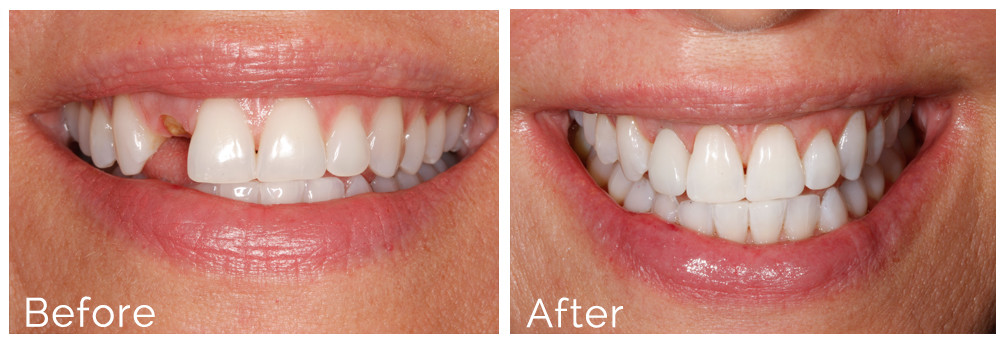Things about Dental Sense
Things about Dental Sense
Blog Article
Our Dental Sense Statements
Table of ContentsThe Main Principles Of Dental Sense Indicators on Dental Sense You Need To Know9 Easy Facts About Dental Sense ExplainedDental Sense Can Be Fun For Anyone
are clinical devices surgically implanted into the jaw to bring back an individual's capability to eat or their look. They offer assistance for synthetic (fake) teeth, such as crowns, bridges, or dentures. When a tooth is lost because of injury or illness, an individual can experience difficulties such as rapid bone loss, faulty speech, or modifications to chewing patterns that result in discomfort.Dental dental implant systems are composed of a dental implant body and oral implant abutment and might additionally include a joint addiction screw. Root canal procedure. The oral implant body is operatively inserted in the jawbone instead of the tooth's origin. The dental implant abutment is usually affixed to the implant body by the joint fixation screw and expands via gums right into the mouth to sustain the attached fabricated teeth
(https://ameblo.jp/dentalsense1/entry-12882048969.html)Framework of The Dental Implant System selecting oral implants, speak to your dental service provider regarding the possible benefits and threats, and whether you are a candidate for the treatment. Points to think about: Your overall health and wellness is a crucial variable in identifying whether you are a great candidate for oral implants, for how long it will certainly require to recover, and how much time the implant may remain in area.
Smoking may affect the recovery process and reduce the long-lasting success of the implant. The recovery process for the dental implant body may take numerous months or longer, throughout which time you generally have a short-term abutment in location of the tooth. the dental implant treatment: Carefully adhere to the dental hygiene guidelines offered to you by your dental copyright.
Fascination About Dental Sense
Implant failing can cause the requirement for an additional operation to deal with or replace the dental implant system. Recovers the ability to eat Restores cosmetic look Helps maintain the jawbone from diminishing as a result of bone loss Maintains the health and wellness of the surrounding bone and periodontals Aids maintain adjacent (nearby) teeth secure Enhances lifestyle Damage to surrounding natural teeth during implant placement Injury to the surrounding cells during surgery, such as sinus opening Injury throughout surgery (for instance, crack of bordering jawbone) Poor feature, such as seeming like the teeth do not attack together generally An experience that the tooth is loosened or turning in location resulting from a joint screw loosening up Implant body failing (looseness of the dental implant body) due to systemic infection, which might be most likely in people with unchecked diabetes mellitus as a result of local infection in bone and gum tissues sustaining the dental implant body due to delayed healing, which might be more most likely in patients that smoke Problem cleansing the periodontals around the dental implant, leading to poor oral hygiene Neglected gum condition Post-surgical pins and needles due to nerve impingement or damages Constantly inform healthcare service providers and imaging service technicians that you have oral implants before any type of magnetic vibration imaging (MRI) or x-ray treatments.
FDA is not mindful of any type of damaging events reported for MRI or x-ray treatments with oral implants. Dental implants systems are commonly made from materials that follow international agreement requirements of the International Company for Standardization (ISO) or ASTM International. These standards have information of what makes a risk-free product.

A dental implant is a framework that replaces a missing out on tooth. With screw-like tools, the specialist inserts an implant right into the jawbone, and it acts as an anchor for a fabricated tooth, called a crown. A device called an abutment connects check over here the man-made tooth to the oral implant. The crown is custom-made to fit the person's mouth and match the color of their teeth.
What Does Dental Sense Do?
Some individuals are not qualified for oral implant surgical procedure. It is for oral cosmetic surgeons to run on people with: intense illnessuncontrollable metabolic diseasebone or soft cells condition or infectionIf these issues are dealt with, a person can have the surgical procedure. In, dental doctors avoid operating people with: If people with any of the above undertake dental implant surgical procedure, there is a greater threat of the implant failing.

Oral implant surgical treatment is a customized process. Give you time to heal. Connect the article and final crown, bridge or denture.
Next, your cosmetic surgeon will carefully put the dental implant right into your jaw. Your doctor will rearrange your gums and shut the laceration with stitches. If your dental implant is near the front of your mouth, your dental practitioner will make a short-term tooth for you to put on until you heal. This way, you won't have a gap in your smile while you recoup.
Unknown Facts About Dental Sense
Your service provider can inform you what to expect in your scenario. Throughout the healing phase, your jawbone should fuse to the oral implant. This process, called osseointegration, is critical for stability and lasting success. This procedure can take anywhere from 3 to nine months. In many cases, it may take much longer.
When your dental implant heals, your dental professional can connect the abutment (little port article) and your last restoration (crown, bridge or denture). This normally takes about one hour to finish and might require a 2nd minor surgery. You should not feel any kind of discomfort throughout your dental implant procedure due to the fact that your service provider will make use of drug to numb your gums.
Report this page